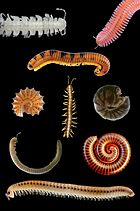| Zosterogrammidae Temporal range: | |
|---|---|
 | |
| Purkynia lata | |
| Scientific classification | |
| Domain: | Eukaryota |
| Kingdom: | Animalia |
| Phylum: | Arthropoda |
| Subphylum: | Myriapoda |
| Class: | Diplopoda |
| Subclass: | Chilognatha |
| Order: | † Zosterogrammida Wilson, 2005 |
| Family: | † Zosterogrammidae Wilson, 2005 |
| Genera | |
Zosterogrammidae is an extinct family of millipedes containing three genera, each with a single species. Fossils are known from the Czech Republic, Scotland, and the USA. Zosterogrammidae constitutes the sole family of the order Zosterogrammida.

